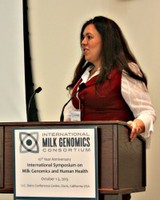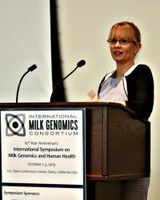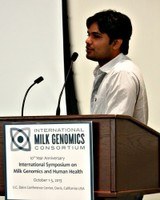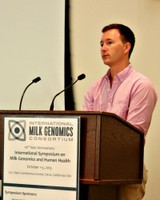IMGC Conference Day 3

The third day of the IMGC Symposium opened with a keynote lecture on analytics by Carlito Lebrilla, Ph.D., Professor in the Department of Chemistry and Department of Biochemistry and Molecular Medicine at UC Davis, titled “The Innovation Enabling Science of Analytics.” In his presentation, Dr. Lebrilla builds on the role that oligosaccharides and glycoconjugates play in establishing the gut flora of infant mammals and that these interactions are made possible by advanced analytic tools that allow rapid structural analysis. However, since milk is highly glycosylated, there are opportunities to study the glycans in proteins and lipids that have been understudied due to a lack of adequate tools.
Dr. Lebrilla and his lab are developing and testing new tools that are able to identify and measure previously-unreachable site-specific glycolipids and glycoproteins. These advanced analytics provide greater understanding of glycan-microbe interactions and the biological complexity of milk.
 The second speaker addressing milk analytics was Andres Guerrero, Ph.D., (pictured, right) a postdoctoral researcher from Dr. Lebrilla’s Lab in the Department of Chemistry at UC Davis. Dr. Guerrero spoke on “Comprehensive Peptidomic Analysis of Human Milk through Lactation.” Dr. Guerrero presented his work on the study of the vast diversity of peptide content in human milk, as a consequence of in vivo digestion. Using human milk samples, Guerrero and his colleagues created the first endogenous (internally-caused) peptide library from human milk. Drawing from this research, they determined that the formation of peptide products exert different roles in human milk, including antibacterial and immune system protection.
The second speaker addressing milk analytics was Andres Guerrero, Ph.D., (pictured, right) a postdoctoral researcher from Dr. Lebrilla’s Lab in the Department of Chemistry at UC Davis. Dr. Guerrero spoke on “Comprehensive Peptidomic Analysis of Human Milk through Lactation.” Dr. Guerrero presented his work on the study of the vast diversity of peptide content in human milk, as a consequence of in vivo digestion. Using human milk samples, Guerrero and his colleagues created the first endogenous (internally-caused) peptide library from human milk. Drawing from this research, they determined that the formation of peptide products exert different roles in human milk, including antibacterial and immune system protection.
David Dallas, Ph.D. (pictured, left) is a postdoctoral researcher with the Foods for Health Institute and the Department of Food Science & Technology at UC Davis, and he spoke on the “Peptidomic Profile of Milk of Holstein Cows at Peak Lactation.” In his research, Dr. Dallas sequences peptides in bovine milk and human milk, comparing qualities and peptide degradation over time.

The final speaker on the topic of analytics was a student travel award winner, Zuzana Krupova (pictured, left), a Ph.D. student at the Institut National de la Recherche Agronomique in Paris, France. Krupova’s presentation, “A Novel LC-MS Protein Profiling Method to Characterize and Quantify Individual Milk Proteins and Multiple Isoforms,” describes the novel process she and others developed to detail a description of milk protein composition which combines liquid chromatography and mass spectrometry. At the end of her presentation, Krupova remarked that she appreciates the knowledge transfer, the opportunity to make new connections, and the international partnerships made possible by the IMGC.
The final section of the International Milk Genomics Consortium examined milk-inspired therapeutics and featured a trio of presenters from Deakin University in Australia. Julie Sharp, Ph.D., a Research Fellow at the Centre for Biotechnology and Interdisciplinary Sciences in the School of Medicine at Deakin University, presented on the “The Innovation Enabling Science of Biology.” Dr. Sharp’s presentation looked at the milk production of “pre-mammals,” and identified both the common lactation practices across mammalian species, but also the different evolutionary lactation strategies that developed over time. Dr. Sharp offered fascinating insights into the lactation strategies of the platypus and echidna.
Two student travel award recipients from the Institute for Technology Research and Innovation at Deakin University delivered the final presentations of the 10th annual IMGC symposium, and both doctoral students focused on the milk of the tammar wallaby. Vengama Modepalli’s presentation, “Developmental Role of Milk in Lung Maturation of Marsupial Pouch Young (Tammar Wallaby),” explained how components of milk were crucial to the development of tammar wallaby lungs, especially for preterm infants. Sanjana Kuruppath’s presentation, “Tammar Wallaby: A Marsupial Model to Understand the Role of Milk in Regulating Stomach Development,” looked at the unique conditions of marsupial stomach development and how mother’s milk has evolved to support that development.



Pictured left to right: Dr. Julie Sharp, Vengama Modepalli, Sanjana Kuruppath from Deakin University
